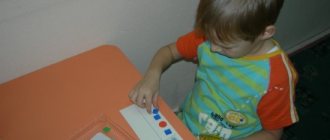What is FFNR?
Speech is not only the direct reproduction of sound, but also its perception. Hearing and speech apparatus are inextricably linked and one part will not work without the other. Exceptions are possible in adulthood, but a child who has encountered phonetic-phonemic speech underdevelopment in childhood will experience severe difficulties in perceiving phonemes, that is, the primary structures of language.
The longer the FNF is not adjusted, the more severe the consequences may be. Against the backdrop of incorrect perception of information, the child’s socialization is threatened, as is his acquisition of more complex skills such as writing and reading. This is also the first step towards dysgraphia and dyslexia - children who are unable to perceive information by ear begin to transfer their experience to other methods of communication and cognition.
Best articles on the site:
Aphasia – acoustic-gnostic form
Apraxia - causes and symptoms
What games do speech therapists use in their work?
Main characteristics of the disease
In the process of developing a child’s speech, one may encounter several symptoms of FFND at once. Here's what you should pay attention to first:
- Children's replacement of some sounds with more convenient articulation. The child does not reproduce some phonemes, replacing them with others. For example, the sounds L and R are replaced by the sounds I and L' (“lozhka” - “l’ozhka” or “lozhka” - “yozhka”);
- It is not uncommon for a child to change all hissing and whistling sounds to simpler articulation sounds, the so-called “explosive” sounds - D, D', T, T' ("scooter" - "tomakat", "fur coat" - "oak") ;
- In some words, children can reproduce sounds correctly, but in most words they change them to ones that are similar in articulation. For example, correctly pronounced sounds l, r and s in a disconnected form in words and phrases are pronounced with defects;
- Children find it difficult to reproduce pairs or groups of sounds separately. There is a substitution of one sound for several. For example, the sound “t'” is replaced for several sounds at once: sh, h, s (“dog” - “tobaka”, “cup” - “tashka”, “shishka” - “tishka”).
Phonetic underdevelopment of speech affects the ability of children to independently identify a sound against the background of a word, determine its correct sequence and quantity. It is difficult to pronounce combinations of simple consonants and polysyllabic words in one sentence. When a child pronounces such words, he skips syllables, replaces difficult sounds, and adds an extra sound inside the syllable. Such a replacement can also manifest itself in writing; as a result, dysgraphia of the articulatory-acoustic type develops.
A child may incorrectly pronounce no more than three sounds or have grammatically correct speech, but not hear the differences between many sounds belonging to different groups. A pronounced underdevelopment of the phonemic process is often veiled under relatively good sound reproduction. Which in turn complicates the diagnosis of the disease.
In addition to verbal disorders, children with FFDD also have other disorders:
- Difficulty switching between tasks;
- Poor understanding of abstract concepts;
- Slow mental movement.
Such disorders lead to poor performance at school, cause mental instability and interfere with normal educational activities.
Forms of phonetic-phonemic speech defects
The speech therapy and pedagogical community distinguishes three main stages in the classification of FFN:
- Easy degree. The child's sound perception is not impaired, but only damaged. Only individual sounds are perceived incorrectly; overall, the analysis is at the normal level.
- Average degree. The number of sounds that the child is not able to perceive increases significantly. It differs from heavy speech in that orientation is still present in oral speech.
- Severe degree. The child has a complete violation of the concept of sound sequence - he does not distinguish them, cannot structure them and isolate them separately from the word.
For all three stages of development of the disorder, consultation or observation with a speech therapist is strictly required if the parents do not have specialized knowledge.
Diagnosis by a speech therapist
The child may be referred to an examination by a speech therapist by an educational institution, a neurologist, or the parents themselves decide to clarify the diagnosis. The speech therapist, based on the medical card, analyzes how the pregnancy and childbirth proceeded, whether there were any complications and what the psychological situation is now in the family.
I draw up a speech card; the doctor notes the state of hearing based on the otolaryngologist’s report, as well as the neurologist’s report on the child’s condition. The pediatrician indicates the preventive measures taken, past illnesses and makes an overall assessment of the child’s health. The speech therapist, in turn, assesses the condition and mobility of the articulatory apparatus, vocal cords and respiratory development.
A detailed analysis of the pronunciation of sounds and syllables is carried out. If any defects are detected, the doctor immediately makes a note on the chart. When assessing sound pronunciation, special attention is paid to various replacements of sounds, mixing them, as well as distortion of the main word. Children should be able to analyze sounds and synthesize them. When assessing oral speech, vocabulary, good coherent speech and the development of the speech line of speech are of great importance.
Written speech also helps to characterize deviations from the norm. The presence of a large number of grammatical errors, replacement of letters (“as I hear, so I write”), errors in understanding a specific word. Based on such a complete picture, the speech therapist makes a conclusion about the state of speech and the presence of FFND in the child.
Causes of phonemic underdevelopment of speech in children
A phonetic-phonemic disorder can be either acquired (most often) or congenital - the perception of sounds can be influenced by both external factors, errors in intrauterine development or birth injuries.
Reasons for acquiring FFN:
- Brain injuries. Concussions, just severe bruises - all this can have an impact.
- Long-term infections or viral diseases. A long illness during the first year, while the immune system has not yet been formed, severely traumatizes all systems, including the nervous one.
- Bad heredity - there was someone in the family with similar problems in childhood.
- Severe nervous shocks and chronic stress during the period of active development of the speech system. This is why FFN can often be found in children from disadvantaged families.
Half of the situations are beyond the influence of parents; they can only seek correction in time. However, even among seemingly prosperous families there are children with functional disabilities - it is possible to create a stressful atmosphere of fear, mistrust and anger in any conditions.
Exercises and games to develop phonemic awareness
Game "Catch the Sound". The adult says a word, and the child’s task is to clap his hands when pronouncing a pre-agreed sound. First, choose words that begin with the desired sound. Then complicate it - the sound should be in the middle or end of the word. The task can be varied to make it more interesting for the child, and also to develop various channels of sound perception. To do this, tell your child words from the next room. After some time, you should read the text in which he will catch the desired sound. This method perfectly trains attention and concentration.
Game "Say the word." The child is told the beginning of a phrase, and he must finish it: to play, you need a game, to sew, you need... (a needle). Come up with as many similar consonances as possible.
Play Rhymes. Say a word and throw the ball to the child. He must catch it and say a rhyme in response. If the rhyme is not named, say it yourself. Start with very simple words and gradually move on to more complex ones. The game is designed for children aged 4-5 years and older.
To make an appointment with a speech therapist or neuropsychologist, call...
Symptoms of phonetic-phonemic speech disorder
The work of a speech therapist begins with diagnosis and, fortunately, small patients with phonetic-phonemic disorders are immediately visible among others. Some symptoms can only be noticed by professionals who conduct tests, and some are noticed by parents themselves.
Main symptoms:
- delay in the development of the nervous system;
- the child’s difficulties with switching attention and, on the contrary, with focusing on something;
- difficulties in pronouncing certain sounds can be traced, there is a system in the child’s mistakes;
- physiological signs such as a “Gothic” high palate and malocclusion, lip structure;
- problems with abstract concepts;
- obvious articulation disorders;
- Possible memory problems.
Basically, a speech therapist understands that he has encountered FFN when he identifies those phonemes that the child does not perceive. If the level of intelligence corresponds to age, as well as vocabulary, there is no doubt.
Features of speech with FFND
With FFNR it is noted:
In addition, characteristic symptoms are:
- replacing or mixing sounds that are similar in phonetic sound;
- insufficient articulation;
- violation of the sequence of sounds and syllables in a word, words in a sentence;
- difficulties in breaking words into syllables;
- errors when changing words by case;
- omissions of syllables, parts of words or whole words (prepositions are often omitted).
Non-verbal symptoms: impaired concentration, increased distractibility, difficulty switching from one activity to another, emotional instability, hyperactivity, poor physical health.
Speech therapy examination for FFN
A speech therapist is the main specialist that such a child will need, but a pediatrician can also diagnose the disorder in consultation with an otolaryngologist. If it is not possible to visit a speech therapist right away, you can safely contact these doctors.
Only a speech therapist can determine the severity of the disease. Upon examination, he will reveal the functionality of the articulatory apparatus and rule out problems with speech for other, more physiological reasons (injuries to the larynx and problems with the respiratory system, for example). The examination consists of a thorough examination of the larynx, studying extracts from other specialists, as well as conducting special tests, based on the results of which it will be possible to accurately judge the FFF.
Speech therapy methods for correcting FFN
If the cause of the disorder is determined to be psychological trauma, the child should be observed by a psychologist in parallel with the speech therapist. When speech disorders occur due to psychological trauma, a speech therapist cannot cope alone.
Correction in preschool institutions
It is the preschooler who is easiest to get rid of FFN quickly and “painlessly” for the child himself. For a preschooler, speech functions are very important, but their need cannot be compared with the junior school level, when the performance factor is included.
It is very important for a speech therapist to complete a full course of correction depending on the degree of severity before primary school age, to understand the structure of an individual defect in FFN. For this purpose, speech practice and targeted work with problematic sounds are used.
Speech therapy correction in elementary grades
If a child already has reading or even writing skills (no matter how well), despite his impairment, it is already necessary to work with him differently. The problem is already considered a reading and writing disorder based on phonetic-phonemic underdevelopment.
Since the child now receives much more information, the speech therapist can introduce problematic phonemes into speech in different ways. A younger schoolchild is capable of more serious sound analysis than a preschooler, but the work is still complicated by the need to “adjust” the child to the norms of social development.
According to the Federal State Educational Standard for Preschool Education (FSES DO): “Speech development includes mastery of speech as a means of communication and culture; enrichment of the active vocabulary; development of coherent, grammatically correct dialogical and monologue speech; development of speech creativity; development of sound and intonation culture of speech, phonemic hearing; acquaintance with book culture, children's literature, listening comprehension of texts of various genres of children's literature; formation of sound analytic-synthetic activity as a prerequisite for learning to read and write.”
Thus, speech development is one of the pressing problems facing preschool institutions. After all, correct speech is one of the indicators of a child’s readiness for school, the key to successful mastery of literacy and reading: written speech is formed on the basis of oral speech. Normal (timely and correct) speech development of a child allows him to constantly learn new concepts, expand his stock of knowledge and ideas about the environment.
The authors M.F. dealt with the development of the phonemic side of speech. Fomicheva, N.L. Krylova, Yu.F. Garkusha, N.Ya.Larionova, T.A.Tkachenko. But you can partially use the recommendations, because their work is aimed at overcoming general speech underdevelopment.
Purpose: to study the process of development of the phonemic aspect of speech of preschool children.
Object of study: the process of development of the phonemic aspect of speech in preschool children.
Research objectives:
- Study literature on the topic of work
- Reveal the stages of development of the phonemic aspect of speech in preschool children
Development of the phonetic-phonemic side of speech in ontogenesis.
In ontogenesis, the development and formation of the phonemic aspect of speech occurs gradually and at different times. Some children pronounce a greater number of sounds and more clearly, others - fewer and less clearly.
Phonemic perception in the process of ontogenesis goes through certain stages:
1) complete lack of differentiation of speech sounds. No understanding of speech. The stage is defined as prephonemic;
2) it becomes possible to distinguish between acoustically distant phonemes, while acoustically close phonemes are not differentiated. A child hears sounds differently than an adult. Distorted pronunciation probably corresponds to misperception of speech. There is no difference between correct and incorrect pronunciation;
3) the child begins to hear sounds in accordance with their distinctive features. However, a distorted, incorrectly pronounced word also correlates with the object. The coexistence of two types of linguistic background: the former, tongue-tied and the formative new one.
4) Expressive speech is almost normal, but phonemic differentiation is still unstable, which manifests itself in the perception of unfamiliar words.
5) Completion of the process of phonemic development, when both the perception and express speech of the child are correct. A sign of transition is the distinction between correct and incorrect pronunciation.
The formation of phonemic perception occurs in close connection with the development of articulation organs.
Physical environmental stimuli that are new to the baby (pain, hunger, uncomfortable position) excite the respiratory and phonation subcortical systems of the brain, resulting in the first cries. From such cries, from the first month, hints of sounds of consonant type m, p, b gradually arise on the basis of the sucking reflex. Children's understanding of speech develops earlier and better than pronunciation. Therefore, the leading role in the development of the phonemic side of speech belongs to hearing. It functions from the first hours of a child’s life. Already from the first month, auditory conditioned reflexes are developed, and from five months this process occurs quite quickly. The baby begins to distinguish the mother's voice, music, etc. Without reinforcement, these reflexes soon fade away. This early involvement of the cortex in hearing development ensures the early development of phonemic speech. But although hearing in its development is ahead of the development of movements of the speech organs, at first it is not sufficiently developed, which causes a number of speech imperfections.
At the turn of the first and second months, at the first manifestations of a pleasant feeling (joy), short sounds appear in the baby - “hooking”. By the end of the second or third month, the child emits sound complexes consisting of noticeably dissected, but insufficiently clear drawn-out sounds; in the third or fourth month the “partying” stage begins. The sounds of the party are similar and have no social meaning. At this age, the primary development of phonemic hearing occurs. In the fifth or sixth month, clearly distinguishable individual sound combinations are pronounced (ma, ba, pa, yes, na), and then, based on autoimitation, they are repeated (ma-ma-ma, ba-ba-ba, pa-pa-pa, dia -dya-dya, na-na-na). Such autoimitation is facilitated by neural pathways already trodden in the brain and supported by developing hearing. The baby enters the babbling stage.
Autoimitation is good preparation for imitating the speech of others. First, the child imitates the sounds of those around him, which he himself pronounces and the articulation of which he sees well, and then the sounds are repeated mainly by ear. By the eighth or ninth month, such imitation becomes the child’s favorite pastime. In the tenth month, the child also imitates sounds from others that he does not yet pronounce on his own.
During this period, the child develops word-like babbling and the sounds of babbling are less associated with instinctive reactions, i.e. Some of them acquire the character of conditioned reflexes, which contributes to the mastery of the sounds of speech of others. The words, intonations and rhythm of speech of adults gradually begin to penetrate into babbling.
Based on conditional connections from seven to eight months, according to N.M. Shchelovanov [Shchelovanov N.M. 1951], the child already understands several words meaning especially brightly colored things, sounding, moving objects, people whom the child sees most often. This also includes games and requests in which the child makes a movement according to a word. From nine to ten months he carries out instructions: “give”, “bring” (first adults show the object). At the same time, he does not yet capture the sound composition of the word, but embraces its sound pattern, intonation, rhythm, as simpler elements of the word. At the age of 1 year to 1 year 3 months, a slow accumulation of the stock of understandable words is observed. During this period, the baby masters independent walking, which expands his ability to directly communicate with the outside world. Walking promotes direct communication between children and surrounding objects (which an adult denotes with a word), helps them establish a strong connection between the object and the word, and leads to a leap in the development of speech understanding.
The child has an increased need for speech - often, in order to satisfy his desires, he asks with facial expressions and gestures. The mother picks up these movements with the words: “Well, say, mom, give me the ball,” etc. The child gradually begins to repeat after his mother, and at about one and a half to two years he begins to speak in separate short phrases. Until the end of the second year, children experience a sort of mechanical repetition of words, ends of questions, ends of heard phrases. By the end of the first year, the child already pronounces individual words, the names of objects with which he deals more often.
Initially, the word means both an object, a goal, and a means of action, i.e. is a proposal. This reveals the situational nature of children’s speech based on the generalization of many conditioned stimuli: here the word expresses an entire situation. The transition from a word-sentence to a sentence of several words requires the ability to break down the unity of the situation into individual components; this occurs when the child has 40-60 words, usually at the age of 1-2 years, notes A.A. Lyublinskaya [Lyublinskaya A.A. 1971]. Only later, with the emergence of a certain content in the child, i.e. understanding of a word, it stands out from the formed sentence as part of it.
Both the initial understanding and mastery of pronunciation in a child are initially based on the rhythm and intonation of the word without distinguishing its sound composition. Discrimination of phonemes occurs relatively slowly: even in the second year, children do not distinguish the words bak, poppy. Only from the second half of the second year does the semantic differentiation of the word begin, and with it the semantic distinguishing function of sounds, i.e. phoneme selection. Accordingly, the articulation is also clarified. The quality of pronounced sounds depends on it. At first, articulation occurs only reflexively, without conscious control, then in some cases it is carried out consciously.
Already at the end of the first half of the year, in the babbling of many children it is possible to distinguish quite clear sounds a, b, p, m, d; then gradually, by the beginning of the second year, e, y, s, o, and appear, i.e. all vowels and consonants in, t, d, k, x, l, s, f. Most of these sounds are not formed immediately in the correct form, but through intermediate, transitional sounds. Such sounds are softened corresponding to normal sounds (дь, ть, нь, сь, ць, рь, л) or similar in the method of articulation. Gradually, through transitional sounds, consonants are differentiated. In this case, all transitional sounds coexist for some time. Every sound substitute represents a certain number of articular movements, corresponding, although not entirely, to the number of movements of the sound being replaced. This not only advances the child along the path of mastering the replaced sound, but enriches the child’s articulatory fund, which facilitates the mastery of other sounds.
Each child has his own dominant sounds, which most often replace other sounds. Later appearing sounds are formed from diffuse sounds of the earlier period.
The diffuseness of sounds makes them unstable: in the same word, first one sound is pronounced, then another. The period of final consolidation of a new sound lasts from 15 to 22 days, sometimes up to three months. The more complex the articulation, the longer the substitute existed and the more it differs from normal articulation, the longer this period.
Isolation of phonemes, according to N.Kh. Shvachkina [Shvachkin N.Kh. 1948]occurs in the process of their phonemic opposition in the following time sequence: first, the vowel a is highlighted, in contrast to other vowels; then they differentiate i-e, u-o, i-u, e-o, i-o, e-u. Then consonant sounds are differentiated into sonorant and noisy. Moreover, for distinguishing sonorous sounds, hearing plays the main role, and noisy ones - articulation. Much later, after about a year, the softness and hardness of consonants differ. In the subsequent differentiation of sonorants among themselves, the child, depending on the individual, relies either on hearing, or on articulation, or on both. Subsequently, labial p, b, m, f, v are the first to stand out from the noisy ones (sight also helps here). They differ from the lingual ones, while the plosives are primarily distinguished as being acoustically brighter and articulatory lighter (p-t, b-d, p-k, b-g, p-f, t-s, k-x) . Further, the lingual front and back rows (t-k, s-x) are distinguished from one another.
Subsequently, more difficult differentiation of voiceless and voiced consonants develops. This distinction is made difficult by the sameness of articulation. Subsequently, there comes a period of differentiation of hissing and whistling sounds and, finally, the difference between l-th and r-th.
As a rule, in the period of formation of consonants, voiceless sounds, not complicated by the work of the larynx, precede voiced ones, plosives predominate over fricative ones, because it is easier for a child to roughly press the organ of speech for a short time than to hold it close at a short distance for a long time. That is why sh, zh, s, z, c appear much later than other consonant sounds - only in the third year, and sometimes even at the end of the fifth year. The hard sounds l and r arise due to the special complexity of their articulations much later than other sounds, often only by the fifth or sixth year and later.
In all cases, the first sound of the word stands out better. This course of phoneme development is observed in most children. A significant part of them rather acquire phonemes acoustically, a smaller part - articulatory, i.e. not all sounds that a child can hear are pronounced by him.
The newly acquired sound for some time becomes a strong irritant - a dominant, and due to insufficient differentiation with the substitute, the latter is forced out even from the places it legally occupies. The longer a “premature” sound lingers in a child’s speech practice, the slower and more difficult it is to acquire its completed form. Since the development of a child’s hearing outstrips the development of his speech motor skills, from the end of the second year pronunciation deficiencies are predominantly caused by imperfections in motor skills. New sounds, similar in articulation, usually appear in a whole group. Therefore, the appearance of one of them is very important.
Of the sound combinations, the most stable are the combinations of the consonants p, b, then t, l, d, k, n, d, mainly with a vowel (pa, ba, ma, pap, bap, nam, etc.). Frequent softening of sounds is caused by large articulatory tension (the opposite rarely happens), which causes a rise in the middle part of the tongue and is observed in emotional speech.
When synthesizing a word, the strength of syllables as sound stimuli plays a decisive role. The child, imitating the word he hears, catches and initially pronounces only the first or only the stressed syllable. An unstressed syllable, especially a pre-stressed one, is often greatly distorted or completely omitted (midoy - tomato, atobil - car, klyandash - pencil). It happens that stressed syllables are also dropped. The more syllables there are in a word, the more often they are omitted. Weak sound analysis, lack of articulation, kinesthetic differentiation and sense of rhythm, according to N.Kh. Shvachkina [Shvachkin N.Kh. 1948] are significant reasons for missing syllables. An open syllable is easier to learn; a closed syllable is less common in children's speech and appears later.
When several consonants come together in one syllable, due to the difficulty of articulation, partly due to the weakness of phonetic analysis, usually only one of them remains: syasno - scary, bassy - big, masya - butter. The most difficult combinations are the following: two plosives (bg), sonorant - plosive (lk), fricative - plosive (st), two fricatives (cx) and consonants with the same (sz) or similar place of formation (sd, vp).
In addition to omissions and substitutions, children aged 3-5 years experience: rearrangements, especially in long words and when they contain r and l (caused by the difficulty of remembering the sequence of sounds in a word): pomolala, kolomotiv, levolver, doublings: nyunyu - one ; merging two words into one: Mifimich instead of Mikhail Efimovich, likening under the influence of the general similarity of words, sounds (bupka instead of bun, bamyazhka instead of piece of paper), premature pronunciation of the subsequent sound in the word.
Such pronunciation features are due to insufficient differentiation of the inhibition process in the area of the auditory analyzer and the resulting weakness of phonemic analysis; in other cases due to the imperfection of the motor analyzer. In a child’s acquisition of speech sounds, it is important to realize their phonemic significance. Meanwhile, up to 3-4 years of age, a child has difficulty distracting himself from the objective content of a word in order to focus his attention on its sound form. At first, he learns phonemes practically, but gradually, year after year, he begins to comprehend the form of the word consciously.
Although at 3-4 years old children do not yet isolate individual sounds from words, they notice irregularities in the sound of words. “I can’t do that.” At this time, they are further developing phonemic perception.
In the fifth year of life, the mobility of the articulatory apparatus increases in children. Most children correctly pronounce hissing sounds, sonorant sounds - r, ry, l; for some of them, the pronunciation of whistling and hissing sounds remains unstable, they are interchangeable. In simple words, children clearly pronounce these groups of sounds, and in complex and unfamiliar words they replace them.
At the age of 6 years, children speak generally correctly, but still a significant number of them (on average, no less than 10 percent) have phonetic speech defects (distortions, often substitutions of sounds).
Conclusion: the phonemic aspect of speech in ontogenesis is unique. At first, the child’s speech is of an impressive nature, it is associated with a direct impression of the object; the child understands, but does not speak yet. By the end of the first year of life (according to N.Kh. Shvachkin), the word for the first time begins to serve as an instrument of communication, acquires the character of a linguistic means, and the child begins to respond to its sound shell (phonemes included in its composition). In the second year of life, children’s the ability to imitate the speech of adults, the understanding of the speech of others intensively develops. By this time, the child begins to actively and independently use words with simple structure in speech.
In the third year of life, the mobility of the articulatory apparatus increases, but the child’s pronunciation does not yet correspond to the norm. Phonemic perception at this time is already well developed: children almost do not mix words that sound similar and try to maintain the syllabic structure of the word.
In the fourth year of life, the articulatory apparatus is further strengthened, and muscle movements become more coordinated. At this time, children notice errors in the pronunciation of others, easily distinguish sound combinations and words that are similar in sound, i.e. They undergo further development of phonemic perception.
By the age of five, children's phonemic processes improve: they recognize sounds in a stream of speech, can choose a word for a given sound, distinguish between increasing or decreasing the volume of speech and slowing down or accelerating the tempo.
By the age of six, children are able to correctly pronounce all the sounds of their native language and words of various syllable structures. A well-developed phonemic ear allows a child to identify syllables or words with a given sound from a group of other words and differentiate phonemes that are similar in sound. The pronunciation side of the speech of a seven-year-old child is as close as possible to the speech of adults, taking into account the norms of literary pronunciation. As a rule, a child has a fairly developed phonemic perception and has some skills in sound analysis (determines the number and sequence of sounds in a word), which is a prerequisite for mastering literacy.
Conclusion.
Thus, an analysis of the literature on the research problem showed that the development of the phonemic aspect of speech is one of the most important tasks in the process of speech development of preschool children. The phonemic aspect of speech includes phonemic hearing, phonemic perception, phonemic analysis and synthesis. All these processes are interconnected and develop in the process of speech ontogenesis. Optimal development of the phonemic aspect of speech is necessary for full mastery of all aspects of speech (lexical, grammatical, coherent speech and sound culture).
The development of phonetic hearing, perception, analysis and synthesis in preschool children is a prerequisite for creating the basis for a child’s mastery of literacy and writing at school. Normal (timely and correct) speech development of a preschooler is important for his overall development and personality formation.
Bibliography.
- Vygotsky L.S., Thinking and speech. Ed.5. corr. - M.: Labyrinth, 1999. - 352 p.
- Egorov T.G., Psychology of mastering the skill of reading. St. Petersburg: KARO, 2006. - 304 p.
- Lyublinskaya A. A. Child psychology. - M.: “Enlightenment”, 1971.
- Order of the Ministry of Education and Science of Russia dated October 17, 2013 No. 1155 “On approval of the federal state educational standard of preschool education” / Order of the Ministry of Education and Science of Russia dated October 17, 2013 No. 1155 “On approval of the federal state educational standard of preschool education”
- Fomicheva M.F. Teaching children correct pronunciation. Textbook for students of pedagogical schools. - M.: Education, 1989. - 239 p.
- Shvachkin, N.Kh. Development of phonemic perception of speech at an early age [Text] // News of the APP of the RSFSR, issue 13. 1948. – 101-133s.
- Shchelovanov N.M. Development of higher nervous activity and education of young children // Soviet Medicine. - 1951. - No. 4.
Articulation exercises
It is not obvious to an adult how much effort a child needs to put in to pronounce words correctly. This is done not by the power of thought, but with the help of the articulatory apparatus, which in turn consists of several important organs. The concept of correcting phonetic-phonemic underdevelopment would not exist without a general set of exercises that can improve the reproducibility of sounds in most young patients.
For active lip work
Our lips literally shape the sounds we make. The typical and familiar facial movements for us have not yet been imprinted in the child’s memory. He, trying to pronounce sounds, fails precisely because of incorrect positioning of his lips
Effective exercises:
- “Kiss” - the child is taught to stretch out his lips with a tube as if for a kiss. Actually helps with the pronunciation of vowels and sibilants.
- “Smile” - the teeth are closed, and the lips spread into the widest possible smile. Trains facial muscles of the lips. You can alternate with the previous exercise.
- “Piglet” - from the “kissing” position, the child is asked to move his closed lips in a circle, changing the direction of rotation.
For tongue training
The tongue is mostly controlled unconsciously - it rises to the palate in a calm state, and its movements during speech are difficult to distinguish for the average person. It is obvious to a specialist that the tongue is the most important part of the articulatory apparatus and it needs to be trained first.
Useful exercises:
- “Needle” - you need to stick your tongue out as far as possible, but at the same time keep it tense so that there is a sharp tip. It is advisable to hold for up to 10 seconds.
- “Scapula” - the task is also to stick your tongue out as far as possible, but in a relaxed state.
- “Medoc” causes a little difficulty for children, but is very effective. It is necessary to lick the upper lip, but not from bottom to top, but from top to bottom.
- “Tube” - roll your tongue into a tube, straining it. The rounder it is, the better.
Clicking and clicking your tongue also helps - it’s not difficult and children are happy to repeat this exercise at home.
Forecast and methods of prevention of FFN
The main method of prevention is the correct, harmonious emotional education of the child. Either an inexperienced or an indifferent parent may not notice the signs of FFF. If you devote enough time to your child, and even better, take him to a psychologist and speech therapist for preventive examinations, he will not face any acquired disorders.
If there is therapy and speech formation in the child at all stages, FFF will disappear after a few months or six months. The problem is solvable and the baby can be pulled out of any degree.
Related posts:
- What is "War and Peace" about? Summary of the novel “War and Peace” by chapters. All answers...
- Logorhythmic classes and correctional means By various means, speech therapy classes contribute to the effective correction of speech in children...
- Interaction with parents of children with ODD Cooperation with parents of children with ODD - many methods are listed…
- What is folklore and how to use its forms? Small forms of folklore are successfully used in various types of activities for…
Possible reasons
- Intrauterine pathology
Toxicosis and viral infections lead to disturbances in the physiological development of the fetus and delayed maturation of brain cells in the last stages of pregnancy.
- Birth injuries
Oxygen starvation and hemorrhages lead to injury to the cerebral cortex. One aspect of speech may be impaired.
- Infectious diseases in young children.
They provoke a weakening of the activity of brain processes.
- Heredity
- Unfavorable influence of environment and upbringing.
Deaf and mute parents, lack of verbal and emotional communication.








